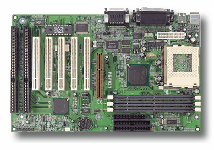Freetech P6F107 i440BX ATX Socket-370
by Mike Andrawes on September 18, 1999 11:58 PM EST- Posted in
- Motherboards
Flexus Technology, under the Freetech brand name, is a fairly recent entry to the motherboard market. Founded in 1990, we're just now seeing their boards popping up everywhere. In their quest for success, their boards have been making the review rounds, including a stop in the AnandTech labs. We checked out their VIA MVP4 based P5F110. Today AnandTech puts the i440BX based P6F107 through its paces.
New Anand Tech Report Card Rating 82/C
| CPU Interface | Socket-370 |
| Chipset | Intel i440BX |
| L2 Cache | N/A (on-chip) |
| Form Factor | ATX |
| Bus Speeds |
66 / 75 / 83 |
| Clock Multipliers | 2.0x - 8.0x |
| Voltages Supported | Auto Detect |
| Memory Slots | 3 168pin DIMM Slots |
| Expansion Slots | 0 AMR Slots 1 AGP Slot 5 PCI Slots (4 Full Length) 2 ISA Slots (1 Shared / 1 Full Length) |
| BIOS | Award 4.51PG |
The Good
One look at the Freetech P6F107 shows a board that looks fairly standard in today's market. This Socket-370 board features a 5/2/1 (PCI/ISA/AGP) slot configuration, complemented by 3 DIMM slots. Optional integrated Creative Labs ES1373 PCI audio provides basic audio functionality for those that don't need 3D positional audio (ie most non-gamers).
The ATX specification is also closely followed with all major components strategically placed to minimize cable clutter and provide the most room to work around the board. All HDD/FDD connectors are located where they should be, right at the front of the board, so that no cables are forced to run over the CPU and/or memory. The ATX power connector is unfortunately located at the back of the board, next to the Socket-370. That means that the power cable will have to run over the CPU and memory, reducing airflow to the CPU and cluttering up the inside of the system. The front panel connectors will prevent the use of a full length card in one ISA slot, while one PCI slot is blocked by a fan connector.
Four 1500uF and two 1000uF are given the responsibility of supplying power to the CPU. This is significantly less capacitance than used by most other manufacturers and probably contributed to the below average stability of the P6F107 in both overclocked and non-overclocked configurations. A typical heatsink is mounted on the i443BX northbridge chip via thermal tape.
A nice touch is the addition of diagnostic LED's on the board. One green and one red LED are located right next to the front panel connectors. Depending on which LED's stay on or blink, one of three different problems can be diagnosed - CPU/motherboard failure, memory failure, or video failure. When both LED's remain off, there is no trouble. This can of course come in quite handy for system builders
A closer look reveals that there are only two jumpers on board, one for disabling the onboard sound and the other for adjusting the AGP divider. The AGP divider can be set to be controlled by the state of BSEL (known as B21 on Slot-1 CPU's) or manually set to 2/3. The rest of the CPU setup is left to the Award BIOS. The CPU settings are under "Chipset Features Setup" with settings for clock multiplier and FSB frequency. Those FSB settings are numerous and include 66 / 75 / 83 / 100 / 103 / 105 / 110 / 112 / 115 / 120 / 124 / 133 / 140 / 150. Most of the higher speeds are useless as overclocking a 66MHz FSB multiplier locked CPU too much above 100MHz FSB is virtually impossible. But for those of you willing to try, settings above 124 are available with a 1/4 PCI ratio to keep things as close to spec as possible. That PCI speed is reported right next to the FSB speed in the BIOS. All settings are available with any CPU installed, but don't forget to set the AGP divider via the aforementioned jumper if you're trying to overclock a 66MHz CPU (such as any current Celeron) to 100MHz or above. The rest of the BIOS is the standard Award 4.51PG fare, with a slight twist. The twist, literally, is that the BIOS menus are all flipped from their normal positions - ones that are normally on the right side of the screen are on the left and vice versa.











0 Comments
View All Comments